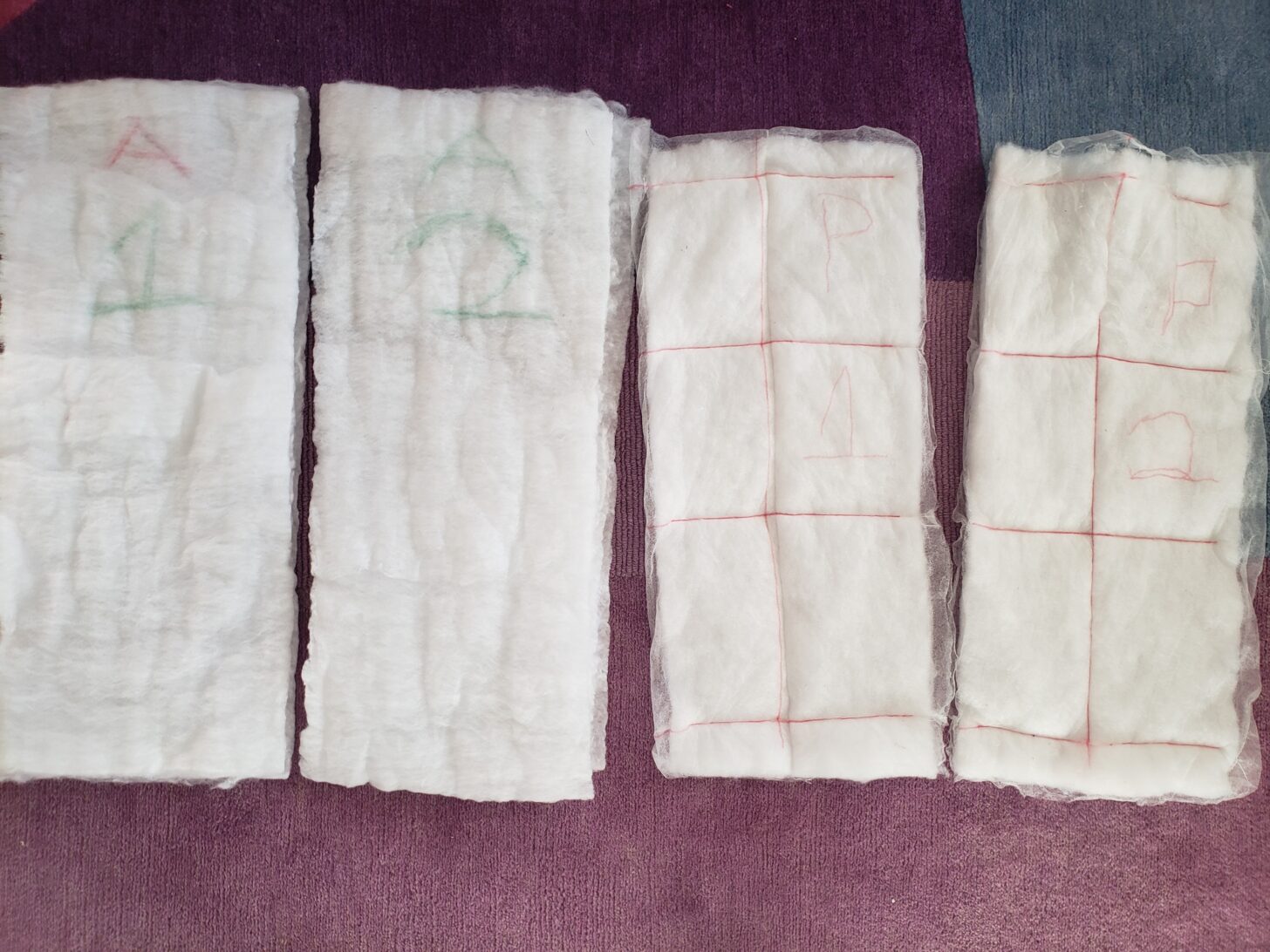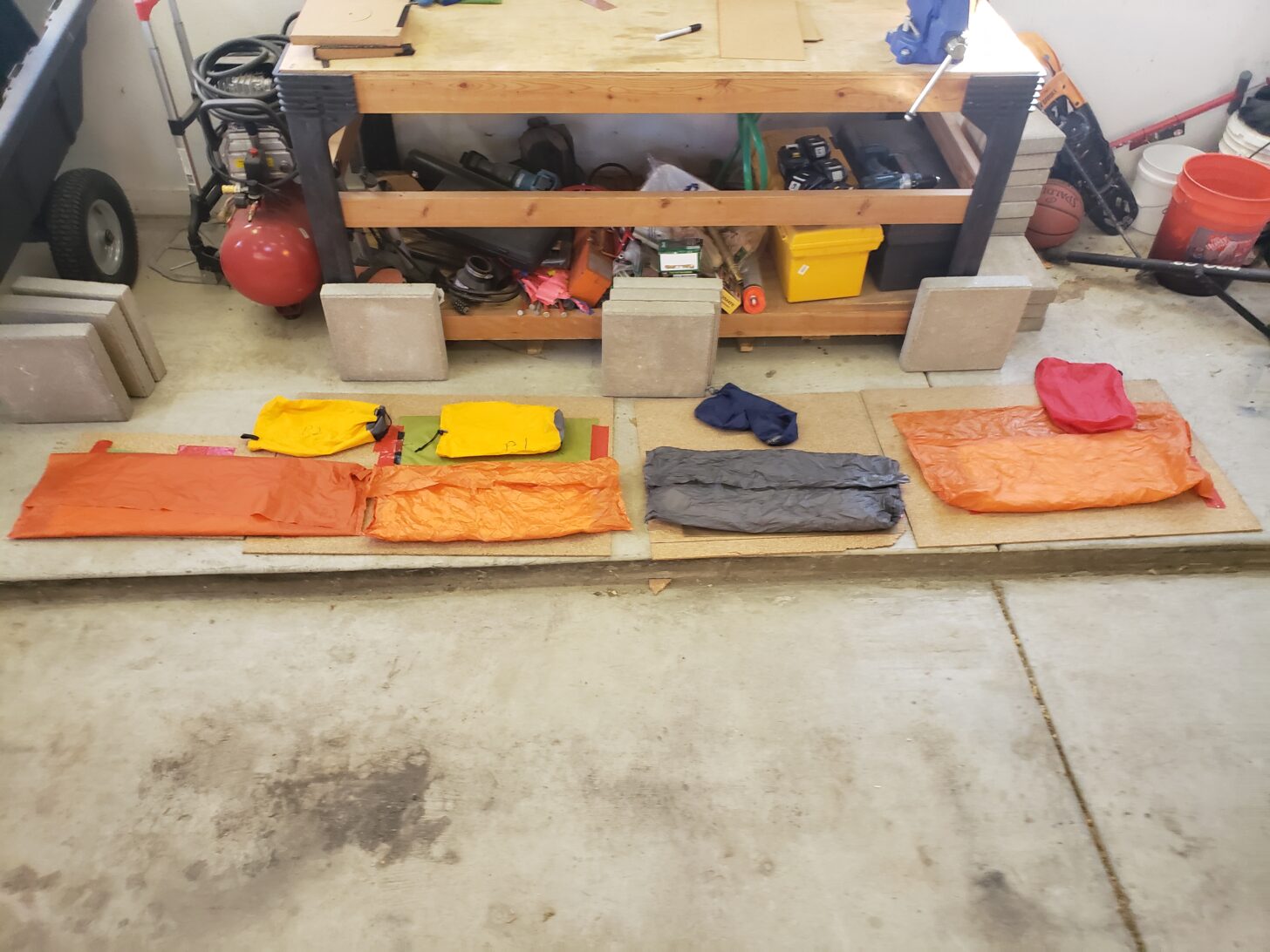Introduction
This is our fourth article evaluating the durability of two market-leading synthetic insulations. In this context, durability describes how the thermal performance of these products might degrade as a result of compression forces experienced during normal use. The more durable insulation will spring back from compression again and again with less loss of thermal performance and loft.
The first article (referred to hereafter as Part 1) in this series subjected 6 ounce per square yard (osy) PrimaLoft Gold and 6 osy Climashield Apex to 10 wash/dry cycles and measured the thermal resistance and loft of each sample at the end of each cycle. In that contest, continuous filament Climashield Apex demonstrated slightly better performance than its short staple competitor, PrimaLoft Gold.
In the second (Part 2) and third (Part 3) articles, we subjected the same two insulations to vertical crushing beneath paving stones. By the time we finished, the insulations had endured 30 crush cycles. Both products demonstrated good durability, but PrimaLoft Gold turned in a somewhat better performance. The test results demonstrated that these insulations, if not abused, could produce good long-term performance – although with some loss of warmth and loft compared to new insulation.
However, during testing for Part 2 and Part 3, we subjected the insulation samples to crushing in a single direction. Concerned readers (and the author) pointed out that these tests failed to replicate the most likely destructive form of insulation abuse: repeatedly cramming a synthetic jacket or sleeping bag into a stuff sack and then jamming that stuff sack into a backpack. The testing in Part 1 and Part 2 did not actually cause the insulation fibers to bend again and again. I am sure many readers have broken a wire or another similarly rigid object by bending it back and forth too many times. Eventually, repeated bending stress to the material results in material failure – it breaks. Similar failure could potentially result from the repeated compression of your synthetically insulated garments. For this fourth (and, I think, final) article in this series (Part 4), we subject our insulation samples to bending forces that simulate cramming our garments into stuff sacks.
Summary of Results
- I tested two different levels of crushing force (1.2 and 3.5 pounds per square inch [psi]). Both crushing forces produced similar thermal and loft changes. Crushing force, in the range tested, made no difference in the rate of degradation. I found the same results in Part 1 and Part 2.
- At the end of the crushing, PrimaLoft Gold lost less of its original thermal performance and provided greater insulation value (it was warmer) than Climashield Apex, even though Climashield started off as the warmer of the two. In the end, although both are of similar weight, PrimaLoft Gold provided more warmth with less loft. Once again, in these crush tests, PrimaLoft Gold outperformed Climashield Apex.
- There are many stories on the web of failures of synthetic insulation due to normal wear and tear from frequent use. Whatever failure users may have experienced with synthetic insulation in the past may not be observed as often in modern insulations.
Testing Methodology
The test procedure varied somewhat from the tests described in previous articles in this series.
Figure 1 shows the insulation samples that were tested. The photograph was taken upon completion of the testing.

In Part 2 and Part 3, I did not quilt any insulation samples. Since only vertical forces were imposed, I felt quilting would be unnecessary. However, PrimaLoft Gold must be quilted in use, according to the manufacturer. Therefore, I decided to quilt the PrimaLoft samples for the present test because we were subjecting the samples to substantially more complex forces than were used in the Part 2 and Part 3 tests.
The PrimaLoft insulation for this test is quilted between two pieces of scrim fabric. The scrim fabric comes layered on the product from the factory so it can be easily handled during the quilting process. The quilting is located along the red lines visible in the photograph. The process of quilting changed the finished dimensions of the samples so that the fit in the guarded hot plate was not as precise as desired. Quilting of the Climashield Apex insulation is not required. Examination of Figure 1 reveals some dimensional changes that occurred over the course of testing both types of insulation.
Both insulations were prepared for testing by inserting them into protective sleeves made from lightweight polyester fabric. This was done because if bare insulation is balled up for crushing, the fibers tend to tangle and ultimately lead to structural damage to the sample, which is not reflective of normal use. The sleeve prevented this problem.
The insulation in the sleeve was then balled up to approximately the size of a fist.
Each balled-up insulation sample was placed in a small stuff sack. The unused volume of the sack was taken up by simply twisting it lightly so that when crushed, air could still escape from the sack. The cross-sectional area of the sack bottom, with the balled-up insulation, was circular, with a diameter of about 5 inches (13 cm).
All test samples were placed beneath pavers. Each sample was subjected to two different forces of compression:
- One sample of each insulation type was placed beneath a single paver. The weight of one paver is 23.4 lb (10.6 kg). The force on the insulation from a single paver is about 1.2 psi.
- In addition, one sample of each insulation type was placed beneath three pavers. The weight of 3 pavers is 70.2 lb (32 kg). The force on the insulation from a stack of three pavers is about 3.5 psi.
Therefore, the compressive forces of this test are considerably higher than those in the prior tests (0.22 and 0.66 psi) described in Part 3.
The compression routine also differed from the tests performed in Part 3. For the test described here, there was one compression period of 12 hours followed by 12 hours of lofting. This was then followed by a cycle of 5 hours of compression, 5 hours of lofting, and another 5 hours of compression. After this, the samples relaxed overnight. On the following day, I completed the insulation (R-value) and loft measurements. I hoped that this testing regimen would provide improved insight into the importance of crush frequency vs. length of time per crush. It also shortened each 3-test cycle by one day. 30 crushes were completed along with 11 thermal and loft measurements.
Figure 2 shows the test sleeves, stuff sacks, and test layout. Figure 3 shows the actual crushing configuration.


Test Results
As in Part 3, the test results are presented in four plots that show data for insulation (R-values) and loft for each type of insulation. The heavy, dashed blue line shows the average for each compression force level. The dotted line is a trend line. These are seen below.
Member Exclusive
A Premium or Unlimited Membership* is required to view the rest of this article.
* A Basic Membership is required to view Member Q&A events




Home › Forums › By the Numbers: Compression Resistance of PrimaLoft Gold vs. Climashield Apex (Part 4)